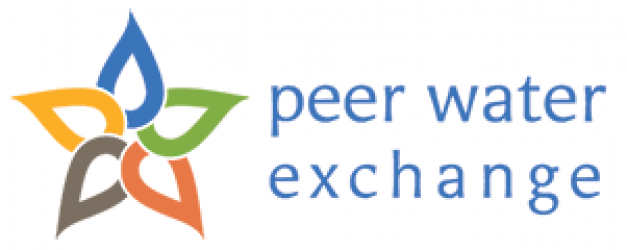When we use our water to bathe and clean we put stuff (cleaners, solvents, chemicals) in it. Our used water flows into our drains and into other eco-systems where other life-forms see this flow as their incoming supply. Thus what we put in impacts others. We can minimize these impacts if using ahimsa (non-violence) as a guiding principles.
Ahimsa is core tenet of Jainism, Buddhism, Hinduism, and most religions.
Published in Jain Spirit in 2002, this essay is about understanding the downstream impacts of our water usage at home and how to minimize them using Jainism principles. Applies to most spiritual traditions, especially Hinduism and Buddhism. Essay appears even more relevant today as places like India use more and more household chemicals and pesticides (even those deemed too toxic and banned in the west).
Our interactions today have become less physical and observable. Faceless people and invisible processes send water to our tap without us being able to identify the source of our water. Our garbage and sewage also disappear from our home without us knowing where and how they end up. This makes it hard for us to determine the himsa (violence), if any, we cause to others, especially the animals and plants who have no voice. However, since we Jains are still responsible for any violence we cause, it is important, to identify our himsa and reduce it.
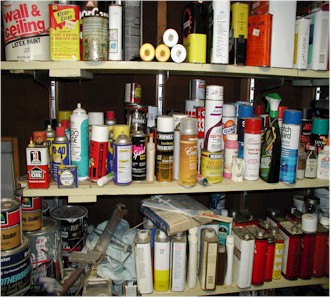
The focus of this essay is on one type of violence we do indirectly on other groups. Individually our himsa is diffused and therefore subtle; collectively it leads to the vast devastation and despair that we have learned to ignore. To start on common ground, i repeat my definition from my previous essay: Preventing a living group from flourishing is himsa.
When my son started crawling, we noticed all the chemicals we stocked in our home. Adults generally know of the dangers of these chemicals and thus don’t drink them. They often wear gloves while using them and even avoid breathing them. But my son was not so knowledgeable and so we began to ‘child-proof’ our house. That lead me to think: if these chemicals were bad for him, weren’t they bad for all the life-forms that are exposed to them?
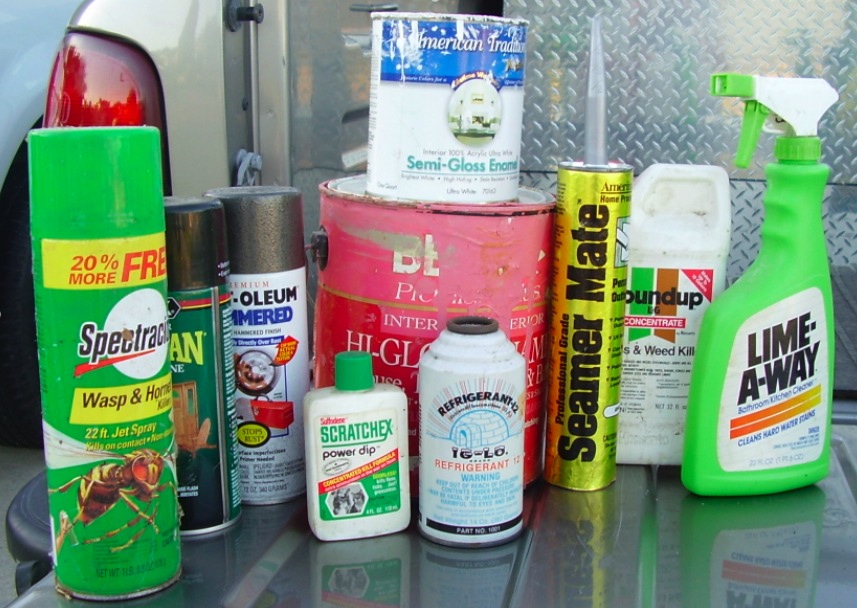
I reflected on the life that lives downstream. Our drains lead to rivers, lakes, and seas. Do the millions of big and small creatures living there appreciate a dose of drain-cleaner in the water they live in, that they breathe? How can
they avoid these poisons (if they become aware of them)? Can they ‘child-proof’ their entire environment?
My thoughts led back to myself: would i notice if the cleaner clearly labeled ‘Poison’ killed some creatures in the San Francisco bay? Would i notice if all my detergents made the waters toxic and slowly squeezed the life out of the bay? Obviously, my dishwashing detergent alone would not cause much harm, but if a million homes dumped a scoop of it every night into the bay, it would easily create a toxic nightmare.
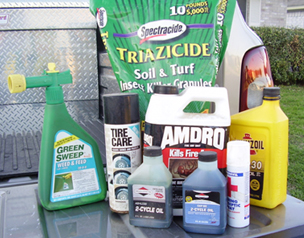
Determined to find out what i was using and what my impacts are, i studied which cleaners
i used, what they contained, what the effects were. I could not believe how
much himsa i was participating in: both in the disposal and the
manufacture.
Due to dilution, mixing, and long-term nature, there is not much research done on the impact of our cleaners on downstream life. In fact, little is known about the impact on chemicals on us! Fewer than 1,000 chemicals (out of over 50,000 now in manufacture) have been tested for immediate acute effects, only about 500 have been tested for their ability to cause cancer, birth defects or genetic changes. Chemicals once thought safe are not: household chemicals can cause headaches, depression, insomnia and flu-like symptoms. There is evidence that many chemicals in our homes are poisonous, carcinogenic, ozone-depleting, and not natural to any ecosystem. This includes detergents, bleaches, synthetic fragrances, artificial dyes, and aerosol propellants. Other chemicals easily found around the home include ammonia, methylene chloride, naphthalene, nitrobenzene, perchloroethylene, sodium hypochlorite, trichloroethane, trichloroethylene, and xylene. Even without a a Ph.D. in chemistry and biology, i was sufficiently alarmed to take the warning labels stating “Poison” and “Hazard” very seriously.
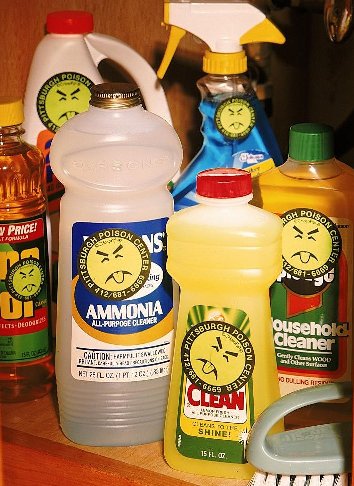
While using (and thus disposing) of these products is harmful, the manufacture may be even more so. While ‘not tested on animals’ is the label in fashion on personal products, the grim reality is that it is really true. We often do not test to see what effect manufacturing chemicals has on life – we just do it. We assume any impact is negligible until proven otherwise after which we consider it a necessary sacrifice. Attending a two-day seminar on the environmental impact of the chemical industry organized by the manufacturers themselves provided the data that my heart already knew: the manufacture of chemicals is a hugely poisonous, and thus violent, affair.
Abandoning this line of research i started what i consider a more Jain approach to research: what were my needs and how could i meet them using the minimum amounts of the gentlest cleaners – causing the least amount of himsa. This research was more fruitful and led to an incredible conclusion: most of my violence was totally unnecessary.
I want to share my findings on how to reduce our himsa caused by our cleaning rituals: personal, laundry, and household. Let us start by learning from the wisdom of our ancestors, which is still valid. The people who built the Ranakpur and Abu temples were clean, wore clean clothes and kept their homes clean. We could learn from their habits and ask ourselves as to why we have moved away from simple cleaners such as water, vinegar, lemon, and baking soda.
The first answer is economics and advertising. If water works better than 50% of the glass cleaners – according to Consumer Reports – in the market, who is going to profit from it? If a spoonful of vinegar added to that water makes it among the best cleaning substance, will you see an ad for it? We start thinking that the simple and effective solutions are old-fashioned, and soon we forget them completely.
The second answer is that we have created very abrasive and toxic cleaners only recently. People washing clothes and dishes with their hands will not tolerate chemicals that harm them. People wearing gloves (a recent practice) do not mind harsher detergents. People using washing machines and dishwashers want their cleaners to be as strong as possible. Actually since these machines cannot give direct attention to stains they require more abrasive substances.
A third answer is that detergents were developed especially to clean synthetic fibers, and are unnecessary for natural fibers such as cotton, linen, silk, and wool. Similarly, to keep fluorescent and other synthetic dyes looking bright we have to use detergents.
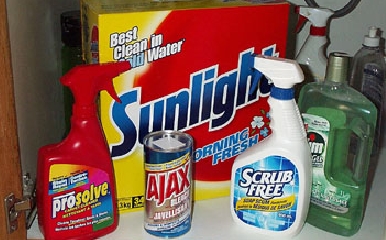
So how do we reduce our violent cleaning behavior with something gentle? We need to do three steps: reduce, substitute, and change.
The first step is Reduce. We can reduce the dosage of all our cleaners. From our soaps and shampoos to our laundry and dishwashing detergents. I cut down quantities by half and everything came out fine. Of course some stains needed direct treatment but the extra manual step was worth reducing my himsa by half. I reduced my consumption of dishwashing detergents by much more than half, especially when i found out that there is a measurable residue that has been known to affect young children.
The next step is to Substitute. My babies were bathed in besan (chick-pea flour) paste, an Indian tradition, instead of soap. If it is good for babies, then it is definitely good enough for me and now i rarely use soap. I can visualize water creatures getting annoyed and even hurt by soap, but being grateful for besan as it is entirely biodegradable and life-friendly.
Our clothing detergent now has no phosphates, no colors, and no fragrances. And the next step is not to use any cleaner some of the time. You don’t always need to use soap or detergent to get clothes clean. If you need to wash clothes to freshen them or remove perspiration or odors, and not remove dirt, a cup of plain baking soda or vinegar will do the trick. For household cleaners, plain water is good enough or add a spoonful of vinegar and keep that solution handy. Baking soda is also another amazing natural cleaner. There are safe substitutes for drain-cleaners, silver polishers, boot polish, and all household chemicals. The interested reader is referred to Home Safe Home by Debra Lynn Dadd. For Jains, using cleaners that contain non-toxic and renewable ingredients should be the default step. We should use products that need no warning labels as that means that they will not cause violence to anybody!
The final step is to Change our habits. We can learn from our monks and use a wet cloth to rub ourselves and not need any cleaners. This habit makes a statement: our bodies are designed to be self-cleansing and self-healing; we do not need fancy products to be hygienic. We can choose natural fibers like cotton and wool that do not require detergents and avoid fluorescent colors. We can stop using the dishwasher and use our own strength to get tough stains out.
Through awareness, education and discipline we can live in a way that respects and nourishes other life.
